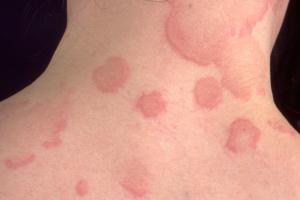Makindo Medical Notes"One small step for man, one large step for Makindo" |
|
|---|---|
| Download all this content in the Apps now Android App and Apple iPhone/Pad App | |
| MEDICAL DISCLAIMER: The contents are under continuing development and improvements and despite all efforts may contain errors of omission or fact. This is not to be used for the assessment, diagnosis, or management of patients. It should not be regarded as medical advice by healthcare workers or laypeople. It is for educational purposes only. Please adhere to your local protocols. Use the BNF for drug information. If you are unwell please seek urgent healthcare advice. If you do not accept this then please do not use the website. Makindo Ltd. |
Urticaria
-
| About | Anaesthetics and Critical Care | Anatomy | Biochemistry | Cardiology | Clinical Cases | CompSci | Crib | Dermatology | Differentials | Drugs | ENT | Electrocardiogram | Embryology | Emergency Medicine | Endocrinology | Ethics | Foundation Doctors | Gastroenterology | General Information | General Practice | Genetics | Geriatric Medicine | Guidelines | Haematology | Hepatology | Immunology | Infectious Diseases | Infographic | Investigations | Lists | Microbiology | Miscellaneous | Nephrology | Neuroanatomy | Neurology | Nutrition | OSCE | Obstetrics Gynaecology | Oncology | Ophthalmology | Oral Medicine and Dentistry | Paediatrics | Palliative | Pathology | Pharmacology | Physiology | Procedures | Psychiatry | Radiology | Respiratory | Resuscitation | Rheumatology | Statistics and Research | Stroke | Surgery | Toxicology | Trauma and Orthopaedics | Twitter | Urology
Urticaria (commonly called hives) is a frequent skin condition, affecting up to 20% of people at some point.
It is characterised by transient, itchy wheals caused by mast cell and basophil activation with release of histamine and other mediators.
Episodes may be acute (<6 weeks, often allergic or infectious trigger) or chronic (>6 weeks, usually idiopathic or autoimmune).
🔑 Key point: Although usually benign and self-limiting, urticaria can overlap with angioedema and in severe cases precede anaphylaxis.
🧬 Aetiology & Pathophysiology
- 💥 Urticaria = transient mast cell & basophil activation → release of histamine, bradykinin, prostaglandins, and leukotrienes.
- 👉 These mediators cause vasodilation + ↑ capillary permeability 💧 → the classic wheal and flare reaction with itch and swelling.
- Immune-mediated:
- Type I hypersensitivity (IgE-mediated: food, insect stings, drugs).
- Type II/III (autoantibodies or immune complexes: autoimmune thyroid disease, SLE).
- Non-immune-mediated:
- Direct mast cell degranulation: opioids, NSAIDs, radiocontrast, vancomycin (“red man”).
- Physical urticarias: cold ❄️, heat 🔥, sunlight ☀️, vibration, pressure, exercise 🏃.
🩺 Clinical Features
- 🌸 Wheals: raised, erythematous, smooth lesions, intensely itchy 🤲, resolving within 24 h.
- ⏱️ Often appear in crops with pale centres and surrounding erythema.
- ✍️ Dermographism: wheals elicited by stroking or pressure.
- 💋 May be accompanied by angioedema (lips, eyelids, tongue, airway).
- 🚨 Severe cases can precede anaphylaxis → monitor for hypotension, stridor, wheeze.
🔎 Common Causes & Triggers
- Drugs 💊: penicillin, NSAIDs, ACE inhibitors, opioids, contrast media.
- Infections 🦠: viral (EBV, hepatitis), bacterial (streptococcus, H. pylori), parasites.
- Immune/Autoimmune 🧩: SLE, RA, autoimmune thyroid disease, cryoglobulinaemia.
- Physical 🌡️: cold, heat, sunlight, pressure, vibration, water 💦.
- Cholinergic urticaria: triggered by sweating, exertion, or emotional stress 😰.
- Idiopathic: the majority of chronic (>6 weeks) cases.
🧪 Investigations
- Usually a clinical diagnosis ✅.
- Chronic/recurrent: FBC, ESR/CRP, thyroid function + antibodies, autoimmune screen.
- Targeted: infection screen; C4/C1 inhibitor for suspected hereditary angioedema.

💊 Management
- 🚫 Avoid triggers: stop offending drug, treat infection, lifestyle modifications for physical urticaria.
- ✅ First-line: Non-sedating antihistamines (e.g. Cetirizine 10 mg OD, Loratadine 10 mg OD, Fexofenadine 180 mg OD). 👉 In chronic urticaria, doses can be escalated up to 4× daily if inadequate response (per BSACI/NICE guidance).
- 💊 Second-line / adjuncts: – Short oral prednisolone (30–40 mg OD × 3–5 days) for acute flares (avoid long-term). – Montelukast or H2 blockers may help in selected cases.
- 💉 Refractory chronic urticaria: Omalizumab (anti-IgE mAb) or ciclosporin under specialist supervision.
- 🚨 Anaphylaxis: IM adrenaline 0.5 mg (1:1000) into the anterolateral thigh → repeat every 5 min if needed. Oxygen, IV fluids, airway management, and hospital admission.
📚 Teaching Pearls
🧠 Differentiate:
– Urticaria: superficial, itchy wheals resolving within 24 h.
– Angioedema: deeper, often painful swelling (lips, tongue, eyelids), persisting longer.
💡 Exam favourite: ACE inhibitor → bradykinin-mediated angioedema (not histamine) → unresponsive to antihistamines or steroids.
🔎 Chronic urticaria (>6 weeks) is usually idiopathic, but always test for thyroid antibodies.
🧾 Clinical Cases
Case 1 – Acute allergic urticaria
A 22-year-old woman develops widespread itchy wheals within 30 minutes of eating prawns at a restaurant. She is otherwise well, with no swelling of lips or tongue.
👉 Diagnosis: IgE-mediated acute urticaria.
👉 Management: Non-sedating antihistamine, avoidance of shellfish. Monitor for progression.
Case 2 – Drug-induced urticaria
A 45-year-old man reports itchy red wheals after starting ibuprofen for back pain. Lesions resolve within 12 hours but recur after each dose.
👉 Diagnosis: NSAID-induced urticaria.
👉 Management: Stop NSAID, treat with antihistamine. Consider alternative analgesic (e.g. paracetamol).
Case 3 – Chronic urticaria
A 50-year-old woman presents with daily itchy wheals for 3 months. No obvious trigger. Bloods show raised thyroid peroxidase antibodies.
👉 Diagnosis: Chronic autoimmune urticaria.
👉 Management: Daily antihistamine (up-titrated if needed). Screen and manage thyroid disease. Refer if refractory (omalizumab/ciclosporin).
Case 4 – Urticaria with angioedema
A 30-year-old man has recurrent urticarial wheals with intermittent lip swelling lasting >24 h. Family history of similar symptoms.
👉 Consider: Hereditary angioedema (C1 esterase inhibitor deficiency).
👉 Management: Specialist referral. Antihistamines are ineffective; treat acute attacks with C1 inhibitor concentrate/icatibant.
Case 5 – Anaphylaxis
A 17-year-old student develops urticaria, lip swelling, stridor, wheeze, and hypotension minutes after a bee sting.
👉 Diagnosis: Anaphylaxis.
👉 Management: IM adrenaline 0.5 mg (1:1000) into the thigh, oxygen, IV fluids, airway support, hospital admission.